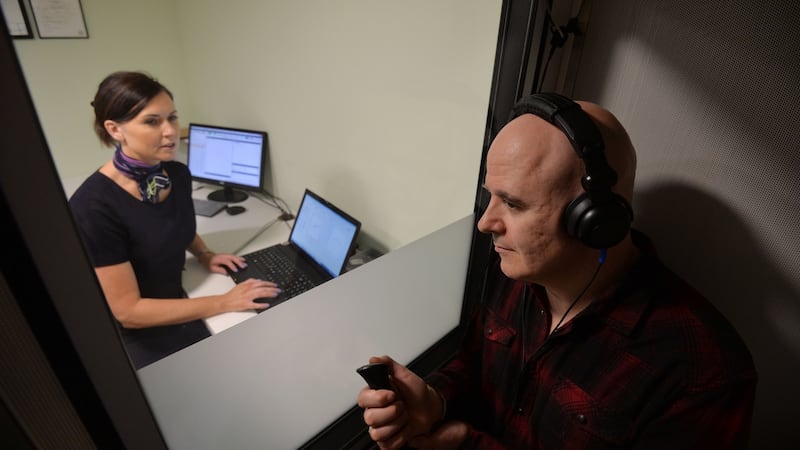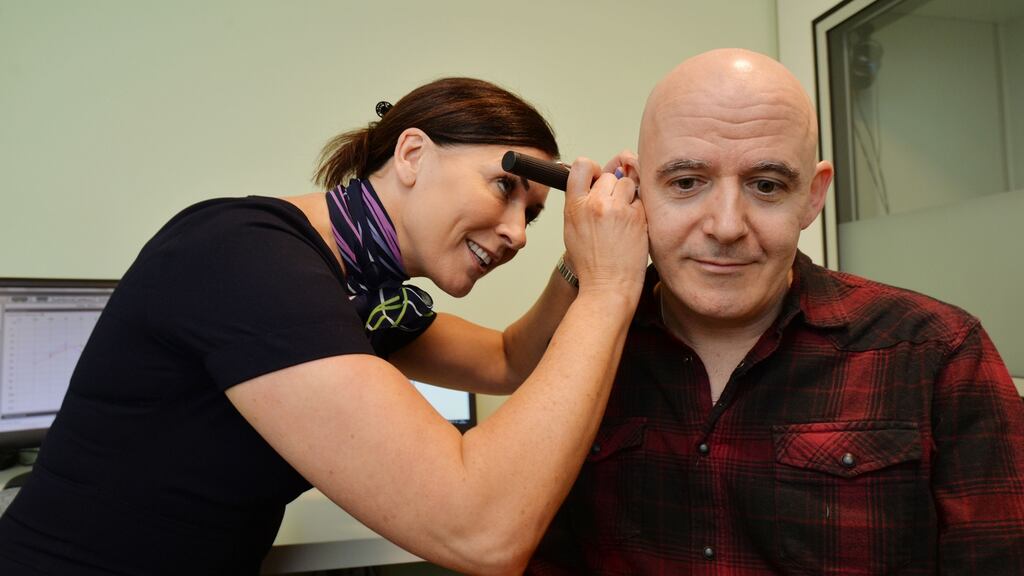My many, many visits to my dentist and my optician over the past 30 years have rarely been a cause of celebration, at least for me. I’ve put my dentist’s children through college with more crowns than all of Europe’s monarch set and my inability to read the top line of eye charts or tell if the red strip or the green strip is clearer has been a cause of much hilarity for the eye people.
But at least I have good ears. I know this because every time I find myself in Specsavers for an all too routine eye appointment, I do the hearing test it runs. And every time I get top marks.
Until today.

"Make sure you bring a hat," I was told on at least three occasions ahead of my visit to audiologist Orla Walsh. So it shouldn't have come as much of a surprise when she asked me where the hat was after she had spent 10 minutes fiddling with my ears.
“I forgot it,” I say, thinking that it won’t make much difference. After all, I am at the Liffey Valley branch of the opticians – who are now also ear people – to have my hearing impaired in the name of research. Whether or not I have a hat on seems irrelevant.
She holds a mirror in front of my face. Huge globs of lurid green putty are spilling from the side of my head where my ears used to be. “You won’t be able to walk around like that, will you?” she says.
No. No I will not.
I only know she has said those words because I am staring intently at her mouth, watching as her lips move. Had she been out of sight when she spoke, all I would have heard would have been a mumble.
Walsh’s idea is not to make me completely deaf, but to give me the type of hearing impairment that many people over the age of 60 live with. Many of those people are completely unaware they have anything wrong with their ears. The lack of awareness is a real problem. And the remedy is very simple.
Hearing loss is a common disorder affecting about one in four people aged between 65 and 75 and half of those over 75. Age-related changes in the inner ear, the middle ear or along the nerve pathways to the brain are to blame.
No complaints
But, because onset is slow, most people don’t really notice the changes and don’t complain. They just think the television needs to be turned up or that people in social settings such as pubs or restaurants mumble more than they used to.
They might get by in a one-to-one setting where they can use the visual clues provided by the lips along with whatever they can hear to engage fully in a conversation.
The people who see the symptoms first tend to be their families. And addressing the issue can be fraught with difficulty.
“It is an emotional thing for a lot of people, a lot more so than eye problems,” Walsh says.
“People are used to getting their eyes tested and they have no problem if they are told they need glasses but it is a different thing when they are told they need a hearing aid. Maybe it is because it is something they associate with ageing. Or maybe it is because they think they will have to wear large hearing aids that will be impossible to miss.”
The truth is 21st century hearing aids lean heavily on digital technology and are unobtrusive, almost to the point of invisibility, particularly if you have hair on your head to cover the apparatus. They are far more sophisticated than the ear amplifiers of old.
Once Walsh injects the green gunk into my ears background noise fades away. I can still hear. I just can't hear everything. I leave Walsh and go straight to Dunnes Stores to look for a hat. I momentarily lose my balance on an escalator in the shop and nearly come tumbling down. I am like a latter day Mr Bean and fear I'm losing my balance. That could be in my head.
Hat secured, I look to call a taxi. That won’t work because I can’t make out what the voice on the other end of the line is saying. All I know is I am shouting. I have to flag a cab instead. The taxi man tries to talk to me. I can’t make out a word he is saying because I don’t have any visual clues. He keeps turning to look at me. I can tell he thinks I am either extremely rude or quite demented.
He turns on the radio. It is talk radio but I can’t hear what the talking heads are saying. I sit quietly in the back of the cab and wait for the journey to end. It is all very peculiar.
Not as peculiar as sitting at my desk. All the background noise in the office is stripped away.
I can’t eavesdrop on the calls of my colleagues and the office banter that is the cornerstone of a working day is cut off.
For a time, the silence enhances my productivity. There are no distractions so I’m more focused. Then I start to miss the distractions and start to fear I am missing out on fun things even though the rational part of my brain tells me this is unlikely. Fun is a scarce enough commodity in the workplace.
Weird looks
People walk past my desk and look at me weirdly, like I have two heads or at least one head and an inappropriate hat; the only one I could find was nuclear orange.
My phone rings but I can’t answer it. Well, I can but I can’t hear much of what people are trying to say to me. I rely instead on text messages.
Home time comes and I decide to walk to get a better sense of what it must be like to live with a serious hearing impairment. The first thing I do is walk under a bus, almost. Again the absence of aural clues is a serious impediment to simple things and, without thinking and without hearing the sounds of oncoming traffic, I step off a footpath. The bus thunders past.
I resolve to pay closer attention to the safe cross code until I get home, all be it with a slightly modified version of rule number three [Editor’s note: If you have forgotten the tune . . . Three, look all around you and listen before you cross the road].
My life is not at risk as long as I watch what is going on. But much of the colour – in an audio sense – has been drained out from the walk home. I can’t hear the snatches of conversation from strangers as I pass them and idle banter with shop assistants and random people disappears.
On the plus side, the volume is dramatically turned down on the Luas works. And when street-cleaning machines go past all I get is the smell.
I get home. And I start to cook. This delivers me another epiphany. Foodie people like to say you eat with your eyes but now I know you cook with your ears. I am frying some garlic. As it cooks I chop with my back to the pan. This is a mistake.
The absence of the spitter spatter of the oil allows me to forget about the garlic, only briefly but long enough for it to burn. So I have to start again.
Conversation
Someone calls to my house. It’s an arranged visit but I have no idea what they are saying so I struggle to take part in the conversation. In fact, it becomes such a chore that I find myself tiring of smiling gamely and I end up zoning out.
Not as much as I zone out when watching the telly though. I am not watching it alone so the option of turning up the volume to the max isn't there. So it stays at a normal level which means I have virtually no idea what is going on. I sit through a re-run of House. I diagnose the patient with Lupus, but, as always, I am wrong. No one ever had Lupus on House.
Finally the time comes for the green gunk to be removed from my ears. I can’t just rip it out myself. Walsh has warned me of the risks to my ear drum if I do. So I go back to Specsavers for it to be taken out by professionals.
Suddenly I can hear again. There are people rowing about cigarettes on Henry Street as I pass them. A man coughs into my face. The spray is disgusting but a hacking cough never sounded so sweet.
How's your hearing? Ask yourself . . .
Have I difficulty hearing the other side of phone calls? Is it harder to make out one-to-one conversations with noise in the background? Is following a conversation when two or more people talk at the same time tricky? Do I think more people are mumbling these days? Do I frequently misunderstand what people say to me? Do I often ask people to repeat what they have said to me? If you answer yes to these questions, visit your GP or make an appointment for a hearing test.
Support services for the deaf and hard of hearing
The Irish Deaf Society works with the deaf and hard-of-hearing community. The society provides information and support, as well as advocating for equality and access. Irishdeafsociety.ie
DeafHear advocates for and provides specialist services and supports to deaf and hard-of-hearing people and their families. Deafhear.ie
The Irish Deaf Youth Association caters for deaf and hard-of-hearing youths. irishdeafyouth.com
Deaf Sports Ireland is the national governing body partnering with the Irish Sports Council and operated by its members through an elected executive board and regional councils, volunteers, and staff. deafsportsireland.com
Specsavers offers free hearing tests. The cost of two digital hearing aids plus add-ons start range from €750-€3,695 for its most high-end models. specsavers.ie











